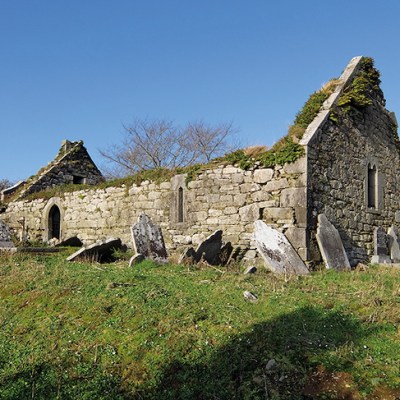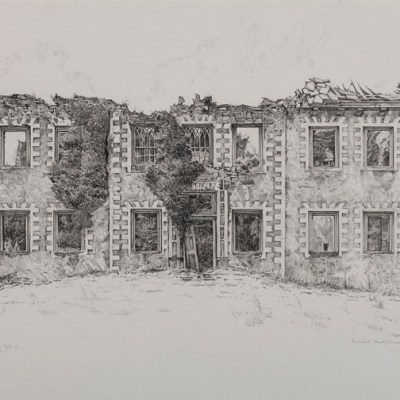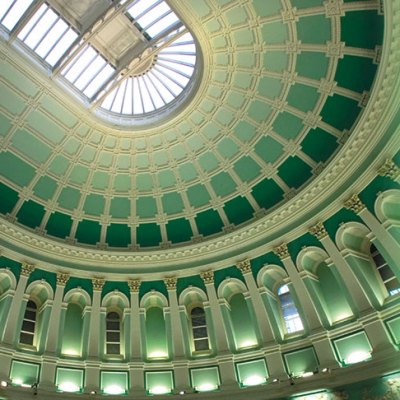Sixty-three years ago, in July 1957, the Irish Times published a short letter enquiring, ‘As the Georgian Society seems to have lapsed, has anyone any objection to my restarting it? Our aims are to bring the photographic records up to date, publish further volumes of the Georgian Society’s books, and fight for the preservation of what is left of Georgian architecture in Ireland.’ The writer was a young man called Desmond Guinness, who, together with his wife Mariga (née Hermione Marie-Gabrielle von Urach), had come to Ireland a couple of years earlier and begun looking for a house to buy. It was while engaged on this quest and travelling about the country that the couple became aware of how many old buildings of note in Ireland were being either neglected or demolished. They were also aware that there had been an organisation called the Irish Georgian Society which from 1908–13 had published a series of volumes recording 18th-century architecture in Ireland. And so, in 1958 the Guinnesses re-founded the society and embarked on a mission that would bring them much success, but also much notoriety and opprobrium.
In the middle of the last century, Ireland still possessed an abundance of fine houses, in both urban and rural settings, testifying to the country’s cultural sophistication during the 18th and early 19th centuries. However, large numbers of these properties had descended into a wretched condition, those in towns and cities often becoming slum tenements, those in the countryside crumbling into ruin. Neglect frequently inspired by active hostility (in the popular imagination, old buildings were associated with the former British regime) had wreaked havoc on Ireland’s architectural heritage. Furthermore, by the 1950s the country was in dire economic straits, both unemployment and emigration reaching record levels. Saving 18th-century houses was low on almost everyone’s list of priorities.
Castletown, County Kildare. Photo: Anne Brady; courtesy Irish Georgian Society

Undaunted, Desmond and Mariga Guinness embarked on the task of creating an organisation which would champion the cause close to their hearts, ‘the preservation of what is left of Georgian architecture in Ireland’. They possessed the advantages of determination and energy, as well as youthful idealism. But for a long time, their crusade faced widespread hostility, not least from the Irish state, which regarded the preservation of old buildings as impeding progress and the modernisation of Ireland. The couple were regarded as members of a privileged elite – ‘belted earls’ was a phrase used by one government minister to belittle their work.
The Guinnesses – and the enlightened supporters they attracted to their cause – refused to be daunted, or to be crushed by the defeats they suffered. They won many battles, but they lost just as many, if not more. Perhaps the most significant of the former was the rescue of Castletown, County Kildare. This important building, the first great Palladian house in Ireland, dating from the early 18th century, was at risk of being lost forever when Desmond Guinness stepped in and used his own funds to save the property. Today Castletown is owned by the state, held up as a splendid example of Irish design and craftsmanship. But if it had not been for Desmond Guinness’s brave initiative, and then the restoration work that he and Mariga oversaw on the house, helped by many young volunteers, Castletown would now be known only through old photographs.
I first met Desmond Guinness when I was an undergraduate, but only in passing. In the early 1980s I had become resident curator of Damer House in County Tipperary (a splendid early 18th-century building which in the mid 1970s the Irish Georgian Society had saved from demolition). One evening, I met Desmond again at a dinner given by mutual friends, and the next day he drove over to Damer House for coffee. It was a difficult period for him: he and Mariga had recently divorced, and Desmond had been subjected – once again – to hostile publicity, with potentially damaging consequences for the society that the couple had established. But he persevered and encouraged a new generation, myself included, to take on the challenges he had already faced.
Desmond could be very persuasive. He was a man blessed with exceptional good looks (he inherited the pale blue eyes of his mother, Diana Mitford) and an amplitude of personal charm, put to excellent use during his frequent fundraising trips to the United States from the mid 1960s onwards. In my own, more recent work on behalf of the Irish Georgian Society, I have frequently encountered elderly American women who melt into blushing belles as they recall encountering Desmond more than half a century ago. In his heyday, he was a tireless advocate of the society and its work, running operations from a room at home in Leixlip Castle, County Kildare, where – when not travelling – he was an unfailingly generous host with flawless manners. Much photographed and admired for its stylish decor created by the Guinnesses in the late 1950s, Leixlip Castle was always the most hospitable of houses, where Desmond was at his most relaxed and engaging. Even though he stepped back from the Irish Georgian Society in the 1990s, he still remained happy to support its endeavours and to entertain its advocates in the house.
Unlike most countries, Ireland has no official honours system. During his lifetime, Desmond never received the acknowledgement that he deserved for his pioneering work in the area of architectural conservation. Following his death on 20 August, tributes to him were rightly led by the country’s president, Michael D. Higgins. The Irish Georgian Society, today more admired than abused but still battling on behalf of Ireland’s architectural heritage, is his most visible legacy. However, he and Mariga (who died in 1989) can also be credited with creating greater appreciation in Ireland of the country’s historic buildings. Without their pioneering work, not just Castletown but many other houses across the island would no longer be standing. The nation is much in their debt.


